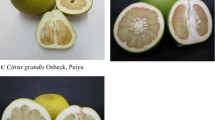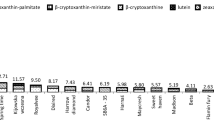Abstract
Grape pomace, a winemaking industry by-product, is a rich source of bioactive dietary compounds. Using proteases we have developed an enzymatic process for obtaining a water-soluble extract (GP-EE) that contains biomolecules such as peptides, carbohydrates, lipids and polyphenols in soluble form. Of especial interest is its high polyphenol content (12 %), of which 77 % are flavonoids and 33 % are phenolic acids. The present study evaluates in vitro the potential anti-inflammatory effect of GP-EE by monitoring the expression of inflammatory molecules on N13 microglia cells stimulated with lipopolysaccharide (LPS). GP-EE decreases the mRNA levels of the inflammatory molecules studied. The molecules under study were as follows: inducible nitric oxide synthase (iNOS), tumor necrosis factor- α (TNF-α), interleukin-1β (IL-1β), the ionized calcium binding adaptor molecule-1(Iba-1) and the Toll like receptor-4 (TLR-4), as well as the iNOS protein level in LPS-stimulated microglia. Our findings suggest that, as a result of its ability to regulate excessive microglial activation, GP-EE possesses anti-inflammatory properties. Therefore, acting as a chemopreventive agent, it may be of therapeutic interest in neurodegenerative diseases involving neuroinflammation. We can, therefore, propose GP-EE as a useful natural extract and one that would be beneficial to apply in the field of functional foods.



Similar content being viewed by others
Abbreviations
- GP:
-
Grape pomace
- GP-EE:
-
Grape pomace enzymatic extract
- LPS:
-
Lipopolysaccharide
- iNOS:
-
Inducible nitric oxide synthase
- TNF-α:
-
Tumor necrosis factor- alpha
- IL-1β:
-
Interleukin-1β
- TLR-4:
-
Toll like receptor-4
- Iba-1:
-
Ionized calcium binding adaptor molecule-1
- UPLC:
-
Ultra-high performance liquid chromatography
- RT:
-
Reverse transcription
References
Rubilar M, Pinelo M, Shene C, Sineiro J, Núñez MJ (2007) Separation and HPLC-MS identification of phenolic antioxidants from agricultural residues: almond hulls and grape pomace. J Agric Food Chem 55:10101–10109
Ariel L, Fontana R, Antoniolli A, Bottini R (2013) Grape pomace as a sustainable source of bioactive compounds: extraction, characterization, and biotechnological applications of phenolics. J Agric Food Chem 61:8987–9003
Luque-Rodríguez JM, Pérez-Juan P, Luque de Castro MD (2006) Extraction of polyphenols from vine shoots of Vitis vinifera by superheated ethanol-water mixtures. J Agric Food Chem 54:8775–8781
Monagas M, Hernández-Ledesma B, Gómez-Cordovés C, Bartolomé B (2006) Commercial dietary ingredients from Vitis vinifera L. leaves and grape skins: antioxidant and chemical characterization. J Agric Food Chem 54:319–327
Kashif Ghafoor K, AL-Juhaimi FY, Choi YE (2012) Supercritical fluid extraction of phenolic compounds and antioxidants from grape (Vitis labrusca B.) seeds. Plant Foods Hum Nutr 67:407–414
Xia EQ, Deng GF, Guo YJ, Li HB (2010) Biological activities of polyphenols from grapes. Int J Mol Sci 11:622–646
McGeer PL, McGeer EG (2004) Inflammation and the degenerative diseases of aging. Ann N Y Acad Sci 1035:104–116
Gao HM, Hong JS (2008) Why neurodegenerative diseases are progressive: uncontrolled inflammation drives disease progression. Trends Immunol 29:357–365
Block ML, Zecca L, Hong JS (2007) Microglia-mediated neurotoxicity: uncovering the molecular mechanisms. Nat Rev Neurosci 8:57–69
Lull ME, Block ML (2010) Microglial activation and chronic neurodegeneration. Neurotherapeutics 7:354–365
Candiracci M, Piatti E, Dominguez-Barragán M, García-Antrás D, Morgado B, Ruano D, Gutiérrez JF, Parrado J, Castaño A (2012) Anti-inflammatory activity of a honey flavonoid extract on lipopolysaccharide-activated N13 microglial cells. J Agric Food Chem 60(50):12304–12311
Bi XL, Yang J, Dong YX, Wang JM, Cui YH, Ikeshima T, Zhao YQ, Wu CF (2005) Resveratrol inhibits nitric oxide and TNF-alpha production by lipopolysaccharide-activated microglia. Int Immunopharmacol 5:185–193
Lu X, Ma L, Ruan L, Kong Y, Mou H, Zhang Z, Wang Z, Wang JM, Le Y (2010) Resveratrol differentially modulates inflammatory responses of microglia and astrocytes. J Neuroinflammation 7:46–60
Ha SK, Moon E, Kim S (2010) Chrysin suppresses LPS-stimulated proinflammatory responses by blocking NF-κB and JNK activations in microglia cells. Neurosci Lett 485:143–147
AOAC (1990) Official methods of analysis, 14th edn. DC. Association of Official Analytical Chemists, Washington
Bautista J, Hernandez-Pinzón I, Alaiz M, Parrado J, Millan F (1996) Low molecular weight sunflower protein hydrolysate with low concentration in aromatic acids. J Agric Food Chem 44:967–971
Singleton VL, Rossi JA Jr (1965) Colorimetry of total phenolics with phosphomolybdic-phosphotungstic acid reagents. Am J Enol Vitic 16:144–158
Righi M, Mori L, De Libero G, Sironi M, Biondi A, Mantovani A, Donini SD, Ricciardi-Castagnoli P (1989) Monokine production by microglial cell clones. Eur J Immunol 19:1443–1448
Gavilán MP, Castaño A, Torres M, Revilla E, Caballero C, Jiménez S, García-Martínez A, Parrado J, Vitorica J, Ruano D (2009) Age-related increase in the immunoproteasome content in rat hippocampus: molecular and functional aspects. J Neurochem 108:260–270
Lowry OH, Rosebrough NJ, Farr AL, Randall RJ (1951) Protein measurement with the folin phenol reagent. J Biol Chem 193:265–275
Ruano D, Revilla E, Gavilán MP, Vizuete ML, Pintado C, Vitorica J, Castaño A (2006) Role of p38 and iNOS in the in vivo dopaminergic cells degeneration induced by inflammatory processes after LPS injection. Neuroscience 140:1157–1168
Kammerer D, Aus A, Schieber A, Carle R (2005) A novel process for the recovery of polyphenols from grape (Vitis vinifera L) pomace. J Food Sci 70:157–163
Gbogouri GA, Linder M, Fanni J, Parmentier M (2006) Analysis of lipids extracted from salmon (Salmo salar) heads by commercial proteolytic enzymes. Eur J Lipid Sci Technol 108:766–775
Rodriguez-Rodriguez R, Justo ML, Claro CM, Vila E, Parrado J, Herrera MD, Alvarez de Sotomayor M (2012) Endothelium-dependent vasodilator and antioxidant properties of a novel enzymatic extract of grape pomace from wine industrial waste. Food Chem 135:1044–1051
Yao H, Jiang YM, Shi J, Tomás-Barberán FA, Datta N, Singanusong R, Chen SS (2004) Flavonoids in food and their health benefits. Plant Foods Hum Nutr 59:113–122
Beutler B (2002) TLR-4 as the mammalian endotoxin sensor. Curr Top Microbiol Immunol 270:109–120
Ito D, Tanaka K, Suzuki S, Dembo T, Fukuuchi Y (2001) Enhanced expression of Iba-1, ionized calcium-binding adapter molecule-1, after transient focal cerebral ischemia in rat brain. Stroke 32:1208–1215
Jeong EJ, Seo H, Yang H, Kim J, Sung SH, Kim YC (2012) Anti-inflammatory phenolics isolated from Juniperus rigida leaves and twigs in lipopolysaccharide-stimulated RAW264.7 macrophage cells. J Enzym Inhib Med Chem 27:875–879
Gómez-Serranillos MP, Martín S, Ortega T, Palomino OM, Prodanov M, Vacas V, Hernández T, Estrella I, Carretero ME (2009) Study of red wine neuroprotection on astrocytes. Plant Foods Hum Nutr 64:238–243
Hernández-Ledesma B, Hsieh CC, de Lumen BO (2013) Chemopreventive properties of Peptide Lunasin: a review. Protein Pept Lett 20(4):424–432
Ransohoff RM, Perry VH (2009) Microglial physiology: unique stimuli, specialized responses. Annu Rev Immunol 27:119–145
Wang J, Weina B, Chen A, Freire D, Vempati P, Zhao W, Gong B, Janle EM, Chen T-Y, Ferruzzi MG, Schmeidler J, Ho L, Pasinetti GMJ (2014) Targeting multiple pathogenic mechanisms with polyphenols for the treatment of Alzheimer’s disease experimental approach and therapeutic implications. Front Aging Neurosci 6:42. doi:10.3389/fnagi.2014.00042
Acknowledgments
This research was supported by a grant of the Ministerio de Innovación y Ciencia, Spain (TRACE 2009-0263-01).
Conflict of Interest
The authors declare no conflicting interests or financial disclosures.
Author information
Authors and Affiliations
Corresponding author
Rights and permissions
About this article
Cite this article
Rodríguez-Morgado, B., Candiracci, M., Santa-María, C. et al. Obtaining from Grape Pomace an Enzymatic Extract with Anti-inflammatory Properties. Plant Foods Hum Nutr 70, 42–49 (2015). https://doi.org/10.1007/s11130-014-0459-0
Published:
Issue Date:
DOI: https://doi.org/10.1007/s11130-014-0459-0




